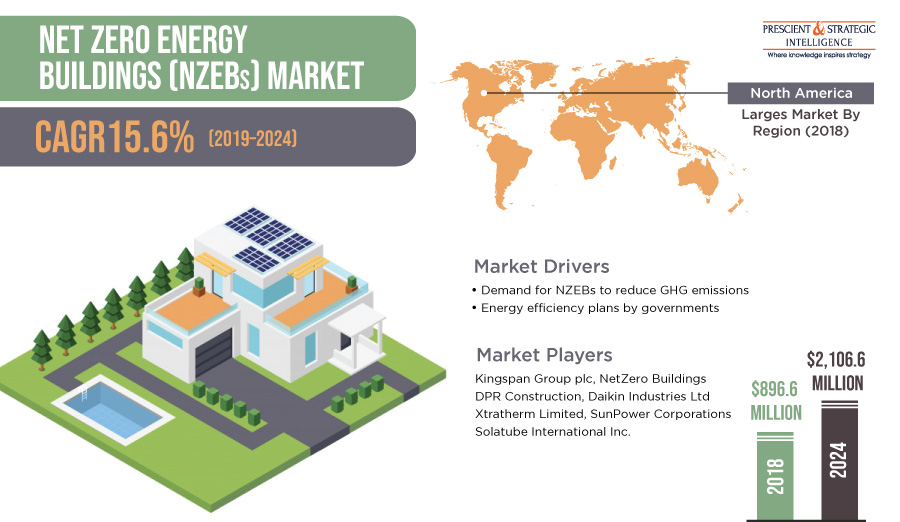In 2018, the global net-zero energy buildings (NZEB) market generated a revenue of $896.6 million and is projected to attain a value of $2,106.6 in 2024, advancing at a 15.6% CAGR during the forecast period (2019–2024). The market is growing due to the plans of government regarding energy efficiency and rising requirement for NZEBs for reducing greenhouse gas (GHG) emissions. A building with zero net energy consumption, that is, the amount of energy utilized by the building is generated through renewable sources on the site, is referred to as NZEB.
In terms of construction, the net-zero energy buildings market is bifurcated into commercial and residential. Between these two, the commercial category held the larger share, of 98.4%, of the market in 2018. This is because commercial construction requires more floor spaces, which results in increased construction value of the building. In addition to this, governments around the world are introducing policies for encouraging the construction of NZEBs for reducing power consumption through fossil fuels. The residential category is predicted to grow at a faster pace during the forecast period.
Request to get sample pages of the report at: https://www.psmarketresearch.com/market-analysis/net-zero-energy-buildings-market/report-sample
When equipment is taken into consideration, the net-zero energy buildings market is categorized into heating, ventilation, & air conditioning systems, solar photovoltaic (PV) panels, lighting systems, insulation panels, and others (which include solar thermal systems and wind turbines). Among these, the solar PV panels dominated the market during the historical period (2014–2018), with a share of 57.1% in 2018. This was because commercial floor spaces need a considerable amount of energy to power all appliances in a building, which results in increased requirement for solar PV panels.
Among all the regions, namely Asia-Pacific, North America, Europe, and Rest of the World, North America accounted for the largest share, of 79.1%, of the net-zero energy buildings market in 2018, and is further predicted to witness the fastest growth during the forecast period. This is because of the rising concerns regarding greenhouse gas emissions, which, in turn, has led to a shift toward NZEB. In addition to this, the increasing number of government initiatives is also resulting in the growth of the market.
One of the key driving factors of the net-zero energy buildings market is the requirement for NZEBs for reducing GHG emissions. The burning of fossil fuels for producing energy has resulted in an increased percentage of carbon dioxide and other harmful gases in the atmosphere. As per the World Green Building Council, construction and buildings account for over 35% of the global energy usage and approximately 40% of energy-related carbon dioxide emissions. Thus, in order to prevent further rise in the percentage of these gases in the atmosphere, several countries are shifting toward NZEBs.
The energy efficiency plans by governments is another major driving factor of the net zero energy buildings market. Several governments around the world are taking various initiatives for using renewable energy at a larger scale and reducing the utilization of non-renewable energy in both commercial and residential areas. Such plans are helping governments in making use of other renewable energy sources for fulfilling the energy requirements. For instance, the California Public Utilities Commission implemented the California Long-Term Energy Efficiency Strategy Plan, with the aim of adopting best practices for energy efficiency.
Hence, the market is registering growth due to the increasing number of initiatives regarding energy efficiency by the government and rising need for NZEBs to reduce GHG emissions.
Browse More Reports:
The global pre-insulated pipes market is projected to reach $9,597.9 million by 2024 from a value of $5,568.5 million in 2018, demonstrating a CAGR of 9.7% during the forecast period. Growing adoption of district heating and cooling (DHC) systems and construction of energy-efficient buildings, both aimed at lowering energy consumption during fluid transportation, are expected to drive the demand for pre-insulated pipes during the forecast period.
https://www.psmarketresearch.com/market-analysis/pre-insulated-pipes-market
The global structural adhesives market is predicted to register a CAGR of 5.2% during the forecast period (2019-2024), reaching $15,683.0 million by 2024. APAC is expected to witness the fastest growth in this market during the forecast period. This can be mainly attributed to the rising infrastructural investments, the number of housing projects, and the growth of the real estate sector.
https://www.psmarketresearch.com/market-analysis/structural-adhesives-market
Media Contact
Company Name: P&S Intelligence
Contact Person: Abhishek
Email: Send Email
Phone: +918887787886
Address:Noida Sector 2
City: Noida
State: UP
Country: India
Website: https://www.psmarketresearch.com/market-analysis/net-zero-energy-buildings-market

